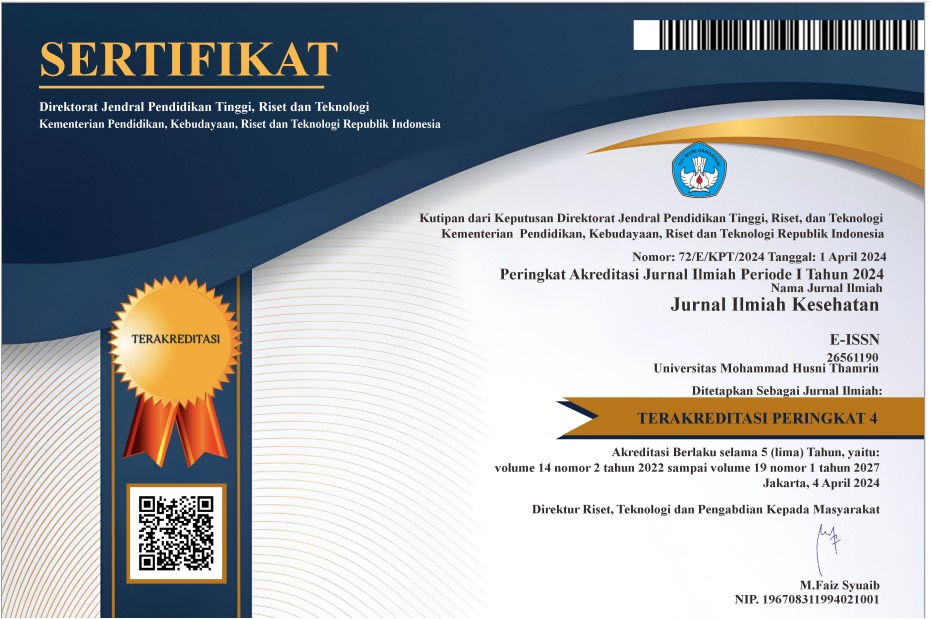Antibakteri α-Mangostin Ekstrak Garcinia mangostana L. terhadap Spesies Staphylococcus aureus dari Isolat Klinik
DOI:
https://doi.org/10.37012/jik.v16i2.2406Keywords:
: α-mangostin, amoxicillin, Staphylococcus aureus, Garcinia mangostana L.Abstract
Infeksi yang disebabkan oleh Staphylococcus aureus (S. aureus) menjadi tantangan besar dalam dunia medis karena resistensi bakteri terhadap antibiotik konvensional. Akibatnya, pengobatan alternatif diperlukan, salah satunya adalah penggunaan bahan alami yang memiliki sifat antibakteri. Studi ini menyelidiki sifat antibakteri α-mangostin ekstrak kulit buah manggis ( Garcinia mangostana L.) terhadap S. aureus dalam isolat klinik.
Untuk mengetahui seberapa efektif antibakteri α-mangostin, penelitian ini menggunakan uji dilusi atau uji minimum inhibitory concentration (MIC). Menurut hasil penelitian, α-mangostin memiliki aktivitas antibakteri yang signifikan terhadap isolat klinik S. aureus, dengan MIC 3.261 ug/mL, sementara MIC amoxicillin adalah 104.375 ug/mL. MIC menunjukkan bahwa, pada konsentrasi rendah, α-mangostin dapat menghentikan pertumbuhan S. aureus. Sedangkan hasil kombinasi menunjukan reduksi yang bermakna yaitu ekstrak kulit buah manggis 0.815 ug/mL dan amoxicillin 26.093 ug/mL.
Kesimpulan dari penelitian ini adalah α-mangostin dari ekstrak manggis (Garcinia mangostana L) dapat berfungsi sebagai antibakteri alami yang dapat menghentikan pertumbuhan S. aureus dan dapat menjadi solusi dalam eradikasi penyakit infeksi bakteri yang resisten terhadap antibiotik.
References
Aljeldah, M. M. (2022). Antimicrobial Resistance and Its Spread Is a Global Threat. Antibiotics, 11(8). https://doi.org/10.3390/antibiotics11081082
Carroll, K. C., Hobden, J. A., Miller, S., Morse, S. A., Mietzner, T. A., Detrick, B., Mitchell, T. G., McKerrow, J. H., & Sakanari, J. A. (2015). Antimicrobial Chemotherapy. In Jawetz, Melnick, & Adelberg’s Medical Microbiology, 27e. http://mhmedical.com/content.aspx?aid=1114735759
Choi, S. H., Dagher, M., Ruffin, F., Park, L. P., Sharma-Kuinkel, B. K., Souli, M., Morse, A. M., Eichenberger, E. M., Hale, L., Kohler, C., Warren, B., Hansen, B., Medie, F. M., Mcintyre, L. M., & Fowler, V. G. (2021). Risk Factors for Recurrent Staphylococcus aureus Bacteremia. Clinical Infectious Diseases, 72(11), 1891–1899. https://doi.org/10.1093/cid/ciaa801
Hassoun, A., Linden, P. K., & Friedman, B. (2017). Incidence, prevalence, and management of MRSA bacteremia across patient populations-a review of recent developments in MRSA management and treatment. Critical Care (London, England), 21(1), 211. https://doi.org/10.1186/s13054-017-1801-3
Mandal, S. M., Tharmalingam, N., Baindara, P., Skurnik mikaelskurnik, M., Arumugam Veera Ravi, helsinkifi, Sivaranjani, M., Leskinen, K., Aravindraja, C., Saavalainen, P., Karutha Pandian, S., Skurnik, M., & Veera Ravi, A. (2019). Deciphering the Antibacterial Mode of Action of Alpha-Mangostin on Staphylococcus epidermidis RP62A Through an Integrated Transcriptomic and Proteomic Approach. https://doi.org/10.3389/fmicb.2019.00150
Miladiyah, I., & Rachmawaty, F. J. (2017). Potency of Xanthone Derivatives as antibacterial agent against Methicillin-Resistant Staphylococcus Aureus (MRSA). Jurnal Kedokteran Dan Kesehatan Indonesia, 8(2), 124–135. https://doi.org/10.20885/jkki.vol8.iss2.art8
Mun, S.-H., Joung, D.-K., Kim, Y.-S., Kang, O.-H., Kim, S.-B., Seo, Y.-S., Kim, Y.-C., Lee, D.-S., Shin, D.-W., Kweon, K.-T., & Kwon, D.-Y. (2013). Synergistic antibacterial effect of curcumin against methicillin-resistant Staphylococcus aureus. Phytomedicine, 20(8–9), 714–718. https://doi.org/10.1016/j.phymed.2013.02.006
Park, S. Y., Lee, J. H., Ko, S. Y., Kim, N., Kim, S. Y., & Lee, J. C. (2023). Antimicrobial activity of α-mangostin against Staphylococcus species from companion animals in vitro and therapeutic potential of α-mangostin in skin diseases caused by S. pseudintermedius. Frontiers in Cellular and Infection Microbiology, 13(May), 1–14. https://doi.org/10.3389/fcimb.2023.1203663
Permana, A., Mazlan, N., Yusuf, E., Anua, S. M., Thung, T. Y., & Baktir, A. (2023). Synergistic effect of commercial mangosteen extract (Garcinia mangostana L.) and amoxicillin against methicillin-resistant Staphylococcus aureus (MRSA). International Food Research Journal, 30(5), 1313–1319. https://doi.org/10.47836/ifrj.30.5.19
Phitaktim, S., Chomnawang, M., Sirichaiwetchakoon, K., Dunkhunthod, B., Hobbs, G., & Eumkeb, G. (2016). Synergism and the mechanism of action of the combination of α-mangostin isolated from Garcinia mangostana L. and oxacillin against an oxacillin-resistant Staphylococcus saprophyticus. BMC Microbiology. https://doi.org/10.1186/s12866-016-0814-4
Sakagami, Y., Iinuma, M., Piyasena, K. G. N. P., & Dharmaratne, H. R. W. (2005). Antibacterial activity of alfa-mangostin against vancomycin resistant Enterococci (VRE) and synergism with antibiotics. Phytomedicine, 12(3), 203–208. https://doi.org/10.1016/j.phymed.2003.09.012
Salam, M. A., Al-Amin, M. Y., Salam, M. T., Pawar, J. S., Akhter, N., Rabaan, A. A., & Alqumber, M. A. A. (2023). Antimicrobial Resistance: A Growing Serious Threat for Global Public Health. Healthcare (Switzerland), 11(13), 1–20. https://doi.org/10.3390/healthcare11131946
Siriwong, S., Teethaisong, Y., Thumanu, K., Dunkhunthod, B., & Eumkeb, G. (2016). The synergy and mode of action of quercetin plus amoxicillin against amoxicillin-resistant Staphylococcus epidermidis. BMC Pharmacology and Toxicology, 17(1), 1–14. https://doi.org/10.1186/s40360-016-0083-8
Turner, N. A., Sharma-kuinkel, B. K., Maskarinec, S. A., Eichenberger, E. M., Shah, P. P., Carugati, M., Holland, T. L., & Fowler, V. G. (2019). Methicillin-resistant Staphylococcus aureus: an overview of basic and clinical research. Nature Reviews Microbiology, 17(April), 203–218. https://doi.org/10.1038/s41579-018-0147-4
Downloads
Published
How to Cite
Issue
Section
Citation Check
License
Copyright (c) 2024 Atna Permana

This work is licensed under a Creative Commons Attribution 4.0 International License.
Jurnal Ilmiah Kesehatan allows readers to read, download, copy, distribute, print, search, or link to the full texts of its articles and allow readers to use them for any other lawful purpose. The journal allows the author(s) to hold the copyright without restrictions. Finally, the journal allows the author(s) to retain publishing rights without restrictions Authors are allowed to archive their submitted article in an open access repository Authors are allowed to archive the final published article in an open access repository with an acknowledgment of its initial publication in this journal.

Lisensi Creative Commons Atribusi 4.0 Internasional.










